#Seneschal of Normandy
Explore tagged Tumblr posts
Text
"Scholars have re-evaluated the patronage role of Henry II and Eleanor of Aquitaine. Examining surviving works from the Plantagenet court, specific evidence of their commissioning is limited. Especially in the case of literary production in Anglo-Norman, Karen Broadhurst has shown that, of the various texts generally held up as part of the cultural production patronised by Henry II, only two were unequivocally commissioned by him: Wace’s Roman de Rou (1160–1170) and Benoît de Saint Maure’s Chronique des Ducs de Normandie (1170–1180), while the other texts can instead be seen as indicating authors’ presumptions about the king’s interests. As far as Eleanor is concerned, there is no evidence directly linking her to systematic advocacy of literature in French, and her influence on the writing of courtly romances cannot be demonstrated. Further developing Karen Broadhurst’s studies on French literature, John Gillingham has reviewed historians’ enthusiastic view of Henry II’s interest in history. Of the various historical works in Latin, the only text that seems to have been directly commissioned by Henry II turns out to be De Majoratu et Senescalcia Franciae, composed in 1158 by Hugh de Claye. Moreover, during the reign of Henry II, many authors—including Richard fitzNigel, Peter of Blois, John of Marmoutier, Gerald of Wales, and Robert of Torigni—proposed historical works to the court but received little atten tion from the king. Gillingham’s analysis recognises that the production of historical works was the expression of the court’s tastes rather than indicating the influence of royal patronage.
A survey of direct patronage by Henry II confirms the king’s inclination for realpolitik as also applied in the field of literary production. The historiographical works commissioned by Henry II were written in the f irst period of his reign, while he was consolidating the bases of his authority over the vast space he was to rule. The works of Wace and Benoit recount the story of the Anglo-Norman kingdom, justifying why an Angevin such as Henry II would have been crowned king. The choice of Anglo-Norman as the language in which to compose these texts was well suited to pursuing this aim in that it enabled the texts to reach an audience of Anglo-Norman nobility directly rather than remaining solely within ecclesiastical circles. The history written by Hugh de Claye recounts how the king of France Louis VI supposedly gave the Counts of Anjou the title of Seneschal of France, reinforcing the Angevin position in Maine and Normandy before Henry II’s expedition to Brittany.
As noted by Ian Short, although the English king and queen cannot be demonstrated to have directly influenced production as patrons through texts dedicated to them, they can still be seen to have exerted influence if we consider the movement of literati who became involved with their courts. To evaluate the motivations of this flock of authors, we must keep in mind that the texts scholars have held up to argue that Henry II’s court was complementary to the king often date from 1170 onwards as well, and as such they are subsequent to the consolidation of his reign and the beginning of conflict with his sons. For royal courtiers, proclaiming the authority of the king of England was another way to assert their own roles. Each author’s principal concern was his own position just as the king’s main concern was his royal authority, and this explains why their works, although not commissioned by the king, did find a favourable reception. Martin Aurell has provided a comprehensive overview of the cultural production of Henry II’s court as a literary transposition of the policies pursued by the English king, showing that the courtiers who theo rised about royal power in England were the same men who participated in the administrative machine of the kingdom and created the specific Angevin courtly culture and its legitimising narratives. The construction of the political ethic of kingdom administration and the construction of the related ideology was thus carried out by the same men and in the same period, starting from 1170 when Henry II’s rule was first contested and then reinforced by his victories."
-Fabrizio De Falco, Authors, Factions, and Courts in Angevin England: A Literature of Personal Ambition (12th–13th Century)
#angevins#12th century#medieval#henry ii#eleanor of aquitaine#english history#my post#this book is REALLY good <3#only downside is that it had nothing on Constance of Brittany and next to nothing on Margaret of France :(
9 notes
·
View notes
Text

Chateau de Carrouges - Normandy - France
The Château de Carrouges is a château, dating partly from the 14th century, located in the commune of Carrouges, in the Orne department, Normandy, northern France. It is unusual in its combination of an austere fortress with a comfortable residence. The original fortifications at Carrouges were besieged and destroyed by English forces during the Hundred Years War. After the war, the château was rebuilt by Jean Blosset, grand seneschal of Normandy, in the 15th century.
3 notes
·
View notes
Text
Le Baud gives a detailed account of the response of the Breton aristocracy ("les Barons’) to this state of affairs. They managed to communicate with the captive Duchess through the Seneschal o f Rennes, who relayed the Duchess’s mandate that the barons should, "se tirassent à son fils Artur, et qu’ils luy fissent fidelité et hommage, et luy servissent et obéissent, en faisant pour luy ainsi qu’ils avoient fait pour elle". Arthur being of such a young age, he would not have received the barons’ homage before, and presumably Constance was seeking to secure Arthur’s succession in the event that she was never freed. Consequently, Le Baud continues, the barons assembled in the presence of Arthur at Saint-Malo de Beignon (canton Guer, arrondissement Ploërmel, département Morbihan). If Le Baud is to be relied upon about the location, it is significant in interpreting the evidence for this assembly. Saint-Malo de Beignon was a rural estate and a summer residence o f the bishops o f Saint-Malo in the hinterland o f the diocese, towards the centre of eastern Brittany. The location may have been chosen for the security of the young Arthur, who had to be protected from being physically taken into custody by Richard’s men. It would have offered greater security to all the participants in the assembly than a location nearer to the coast or the eastern frontier. The latter was completely controlled by the Angevin ruler as Duke o f Normandy, Count of Anjou, and Count of Poitou. It was also neutral territory in the sense that it was not ducal territory, and it was physically quite central and proximate to the estates of most of the barons involved. Le Baud implies that the barons assembled at Saint-Malo de Beignon to render homage, at the request of Duchess Constance, because Arthur was already there. The implication that Arthur was staying at a residence of the Bishop o f Saint-Malo suggests that the bishop played an important role in this affair. Perhaps more generally the impetus came from the bishops, because the Bishop o f Vannes, Guethenoc, also took an active role, later taking responsibility for the delivery of Arthur to the custody of Philip II Augustus o f France (1180-1223). Bishops would also have had the administrative resources, for instance, to draft and send out letters of summons.
Judith Everard, Aristocratic Assemblies in Brittany, 1066 -1203
2 notes
·
View notes
Text
the Otherworldly Companion (OC) masterpost
(aka "who the fuck are these people you're tagging")
Nuadha is what's commonly called the "Dark Urge", but with some modifications. She is an avatar of a largely-forgotten god (in this part of Toril, anyway) who ran afoul of both Bhaal and his Chosen. She travels Faerûn in the company of future Hero of Baldur's Gate Wyll Ravengard searching for a cure to a mindflayer affliction and a reunion with the sundered fragments of her Self.
Dayir and Ishan are my Eorzean Warriors of Varying Luminosity, as it were, and there's a lil about post about them here. Sesshai is their tricksy Viera bestie that I don't talk about nearly enough, for some reason.
Noah Kingfisher is the Sole Survivor of Vault 111; Gabriel the Revelator is the Lone Wanderer; and Gideon of the Grave is Courier Six. Noah is a literal child of Atom, and Gabriel is the next-closest thing, being genetically manipulated by Atom in utero. Noah also exists in Halcyon and Far Cry 5's Montana (along with Preston Garvey).
Anansi Surana is both the Grey Warden that ends the Blights once and for all, and the Herald of [???] (Razikale, but no one knows that) that lays the groundwork for a new world. he's also a First Enchanter for a while. he gets around, you could say. Elijah Wolf (or, Elijah Hawk-child, for much of DA2) is Lord Protector of Kirkwall but that doesn't stop him or his seneschal Varric Tethras from gallivanting off to Skyhold. I don't play in the Dragon Age space much anymore, unfortunately, so don't expect much about these guys unless they respawn in another universe (which is highly possible). or unless I play DA4. which is also possible.
Adrian Shepard is Commander of the SSV Normandy and the scourge of the Reapers. until he becomes something bigger than the Reapers. good thing he's on our side.
Claudio V Invictus is the Saint of Saints and the CEO of Saintscorp. he is the owner of every single pair of the booty shorts in those "shorts that say [x] on the ass" memes.
there are others -- Keahi the Watcher of Caed Nua, Llovyn Arendur of Skyrim, Ananduil and Venanduil of Azeroth, loads more Thedosians, etc -- but they don't have populated tags yet because they simply haven't come up nearly as often.
questions, comments, crack headcanons, etc about anyone here are extremely encouraged and appreciated. you truly cannot go wrong
(side note: #spicy oc tag is where all the nasty posts go. because there will be nasty posts. I delight in debauchery)
4 notes
·
View notes
Text
Magna Carta, 1215
JOHN, by the grace of God King of England, Lord of Ireland, Duke of Normandy and Aquitaine, and Count of Anjou, to his archbishops, bishops, abbots, earls, barons, justices, foresters, sheriffs, stewards, servants, and to all his officials and loyal subjects, Greeting.
KNOW THAT BEFORE GOD, for the health of our soul and those of our ancestors and heirs, to the honour of God, the exaltation of the holy Church, and the better ordering of our kingdom, at the advice of our reverend fathers Stephen, archbishop of Canterbury, primate of all England, and cardinal of the holy Roman Church, Henry archbishop of Dublin, William bishop of London, Peter bishop of Winchester, Jocelin bishop of Bath and Glastonbury, Hugh bishop of Lincoln, Walter bishop of Worcester, William bishop of Coventry, Benedict bishop of Rochester, Master Pandulf subdeacon and member of the papal household, Brother Aymeric master of the knighthood of the Temple in England, William Marshal earl of Pembroke, William earl of Salisbury, William earl of Warren, William earl of Arundel, Alan of Galloway constable of Scotland, Warin fitz Gerald, Peter fitz Herbert, Hubert de Burgh seneschal of Poitou, Hugh de Neville, Matthew fitz Herbert, Thomas Basset, Alan Basset, Philip Daubeny, Robert de Roppeley, John Marshal, John fitz Hugh, and other loyal subjects:
+ (1) FIRST, THAT WE HAVE GRANTED TO GOD, and by this present charter have confirmed for us and our heirs in perpetuity, that the English Church shall be free, and shall have its rights undiminished, and its liberties unimpaired. That we wish this so to be observed, appears from the fact that of our own free will, before the outbreak of the present dispute between us and our barons, we granted and confirmed by charter the freedom of the Church's elections - a right reckoned to be of the greatest necessity and importance to it - and caused this to be confirmed by Pope Innocent III. This freedom we shall observe ourselves, and desire to be observed in good faith by our heirs in perpetuity.
TO ALL FREE MEN OF OUR KINGDOM we have also granted, for us and our heirs for ever, all the liberties written out below, to have and to keep for them and their heirs, of us and our heirs:
(2) If any earl, baron, or other person that holds lands directly of the Crown, for military service, shall die, and at his death his heir shall be of full age and owe a 'relief', the heir shall have his inheritance on payment of the ancient scale of 'relief'. That is to say, the heir or heirs of an earl shall pay £100 for the entire earl's barony, the heir or heirs of a knight 100s. at most for the entire knight's 'fee', and any man that owes less shall pay less, in accordance with the ancient usage of 'fees'.
(3) But if the heir of such a person is under age and a ward, when he comes of age he shall have his inheritance without 'relief' or fine.
(4) The guardian of the land of an heir who is under age shall take from it only reasonable revenues, customary dues, and feudal services. He shall do this without destruction or damage to men or property. If we have given the guardianship of the land to a sheriff, or to any person answerable to us for the revenues, and he commits destruction or damage, we will exact compensation from him, and the land shall be entrusted to two worthy and prudent men of the same 'fee', who shall be answerable to us for the revenues, or to the person to whom we have assigned them. If we have given or sold to anyone the guardianship of such land, and he causes destruction or damage, he shall lose the guardianship of it, and it shall be handed over to two worthy and prudent men of the same 'fee', who shall be similarly answerable to us.

(5) For so long as a guardian has guardianship of such land, he shall maintain the houses, parks, fish preserves, ponds, mills, and everything else pertaining to it, from the revenues of the land itself. When the heir comes of age, he shall restore the whole land to him, stocked with plough teams and such implements of husbandry as the season demands and the revenues from the land can reasonably bear.
(6) Heirs may be given in marriage, but not to someone of lower social standing. Before a marriage takes place, it shall be made known to the heir's next-of-kin.
(7) At her husband's death, a widow may have her marriage portion and inheritance at once and without trouble. She shall pay nothing for her dower, marriage portion, or any inheritance that she and her husband held jointly on the day of his death. She may remain in her husband's house for forty days after his death, and within this period her dower shall be assigned to her.
(8) No widow shall be compelled to marry, so long as she wishes to remain without a husband. But she must give security that she will not marry without royal consent, if she holds her lands of the Crown, or without the consent of whatever other lord she may hold them of.
(9) Neither we nor our officials will seize any land or rent in payment of a debt, so long as the debtor has movable goods sufficient to discharge the debt. A debtor's sureties shall not be distrained upon so long as the debtor himself can discharge his debt. If, for lack of means, the debtor is unable to discharge his debt, his sureties shall be answerable for it. If they so desire, they may have the debtor's lands and rents until they have received satisfaction for the debt that they paid for him, unless the debtor can show that he has settled his obligations to them.
* (10) If anyone who has borrowed a sum of money from Jews dies before the debt has been repaid, his heir shall pay no interest on the debt for so long as he remains under age, irrespective of whom he holds his lands. If such a debt falls into the hands of the Crown, it will take nothing except the principal sum specified in the bond.
* (11) If a man dies owing money to Jews, his wife may have her dower and pay nothing towards the debt from it. If he leaves children that are under age, their needs may also be provided for on a scale appropriate to the size of his holding of lands. The debt is to be paid out of the residue, reserving the service due to his feudal lords. Debts owed to persons other than Jews are to be dealt with similarly.
* (12) No 'scutage' or 'aid' may be levied in our kingdom without its general consent, unless it is for the ransom of our person, to make our eldest son a knight, and (once) to marry our eldest daughter. For these purposes only a reasonable 'aid' may be levied. 'Aids' from the city of London are to be treated similarly.
+ (13) The city of London shall enjoy all its ancient liberties and free customs, both by land and by water. We also will and grant that all other cities, boroughs, towns, and ports shall enjoy all their liberties and free customs.
* (14) To obtain the general consent of the realm for the assessment of an 'aid' - except in the three cases specified above - or a 'scutage', we will cause the archbishops, bishops, abbots, earls, and greater barons to be summoned individually by letter. To those who hold lands directly of us we will cause a general summons to be issued, through the sheriffs and other officials, to come together on a fixed day (of which at least forty days notice shall be given) and at a fixed place. In all letters of summons, the cause of the summons will be stated. When a summons has been issued, the business appointed for the day shall go forward in accordance with the resolution of those present, even if not all those who were summoned have appeared.
* (15) In future we will allow no one to levy an 'aid' from his free men, except to ransom his person, to make his eldest son a knight, and (once) to marry his eldest daughter. For these purposes only a reasonable 'aid' may be levied.
(16) No man shall be forced to perform more service for a knight's 'fee', or other free holding of land, than is due from it.
(17) Ordinary lawsuits shall not follow the royal court around, but shall be held in a fixed place.
(18) Inquests of novel disseisin, mort d'ancestor, and darrein presentment shall be taken only in their proper county court. We ourselves, or in our absence abroad our chief justice, will send two justices to each county four times a year, and these justices, with four knights of the county elected by the county itself, shall hold the assizes in the county court, on the day and in the place where the court meets.
(19) If any assizes cannot be taken on the day of the county court, as many knights and freeholders shall afterwards remain behind, of those who have attended the court, as will suffice for the administration of justice, having regard to the volume of business to be done.
(20) For a trivial offence, a free man shall be fined only in proportion to the degree of his offence, and for a serious offence correspondingly, but not so heavily as to deprive him of his livelihood. In the same way, a merchant shall be spared his merchandise, and a villein the implements of his husbandry, if they fall upon the mercy of a royal court. None of these fines shall be imposed except by the assessment on oath of reputable men of the neighbourhood.
(21) Earls and barons shall be fined only by their equals, and in proportion to the gravity of their offence.
(22) A fine imposed upon the lay property of a clerk in holy orders shall be assessed upon the same principles, without reference to the value of his ecclesiastical benefice.
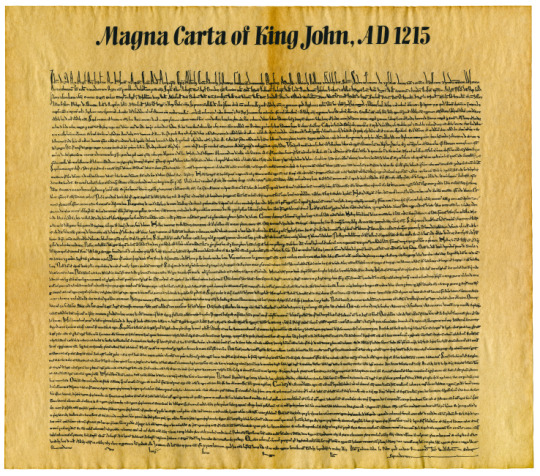
(23) No town or person shall be forced to build bridges over rivers except those with an ancient obligation to do so.
(24) No sheriff, constable, coroners, or other royal officials are to hold lawsuits that should be held by the royal justices.
* (25) Every county, hundred, wapentake, and tithing shall remain at its ancient rent, without increase, except the royal demesne manors.
(26) If at the death of a man who holds a lay 'fee' of the Crown, a sheriff or royal official produces royal letters patent of summons for a debt due to the Crown, it shall be lawful for them to seize and list movable goods found in the lay 'fee' of the dead man to the value of the debt, as assessed by worthy men. Nothing shall be removed until the whole debt is paid, when the residue shall be given over to the executors to carry out the dead man’s will. If no debt is due to the Crown, all the movable goods shall be regarded as the property of the dead man, except the reasonable shares of his wife and children.
* (27) If a free man dies intestate, his movable goods are to be distributed by his next-of-kin and friends, under the supervision of the Church. The rights of his debtors are to be preserved.
(28) No constable or other royal official shall take corn or other movable goods from any man without immediate payment, unless the seller voluntarily offers postponement of this.
(29) No constable may compel a knight to pay money for castle-guard if the knight is willing to undertake the guard in person, or with reasonable excuse to supply some other fit man to do it. A knight taken or sent on military service shall be excused from castle-guard for the period of this service.
(30) No sheriff, royal official, or other person shall take horses or carts for transport from any free man, without his consent.
(31) Neither we nor any royal official will take wood for our castle, or for any other purpose, without the consent of the owner.
(32) We will not keep the lands of people convicted of felony in our hand for longer than a year and a day, after which they shall be returned to the lords of the 'fees' concerned.
(33) All fish-weirs shall be removed from the Thames, the Medway, and throughout the whole of England, except on the sea coast.
(34) The writ called precipe shall not in future be issued to anyone in respect of any holding of land, if a free man could thereby be deprived of the right of trial in his own lord's court.
(35) There shall be standard measures of wine, ale, and corn (the London quarter), throughout the kingdom. There shall also be a standard width of dyed cloth, russet, and haberject, namely two ells within the selvedges. Weights are to be standardised similarly.
(36) In future nothing shall be paid or accepted for the issue of a writ of inquisition of life or limbs. It shall be given gratis, and not refused.
(37) If a man holds land of the Crown by 'fee-farm', 'socage', or 'burgage', and also holds land of someone else for knight's service, we will not have guardianship of his heir, nor of the land that belongs to the other person's 'fee', by virtue of the 'fee-farm', 'socage', or 'burgage', unless the 'fee-farm' owes knight's service. We will not have the guardianship of a man's heir, or of land that he holds of someone else, by reason of any small property that he may hold of the Crown for a service of knives, arrows, or the like.
(38) In future no official shall place a man on trial upon his own unsupported statement, without producing credible witnesses to the truth of it.
+ (39) No free man shall be seized or imprisoned, or stripped of his rights or possessions, or outlawed or exiled, or deprived of his standing in any way, nor will we proceed with force against him, or send others to do so, except by the lawful judgment of his equals or by the law of the land.
+ (40) To no one will we sell, to no one deny or delay right or justice.
(41) All merchants may enter or leave England unharmed and without fear, and may stay or travel within it, by land or water, for purposes of trade, free from all illegal exactions, in accordance with ancient and lawful customs. This, however, does not apply in time of war to merchants from a country that is at war with us. Any such merchants found in our country at the outbreak of war shall be detained without injury to their persons or property, until we or our chief justice have discovered how our own merchants are being treated in the country at war with us. If our own merchants are safe they shall be safe too.
* (42) In future it shall be lawful for any man to leave and return to our kingdom unharmed and without fear, by land or water, preserving his allegiance to us, except in time of war, for some short period, for the common benefit of the realm. People that have been imprisoned or outlawed in accordance with the law of the land, people from a country that is at war with us, and merchants - who shall be dealt with as stated above - are excepted from this provision.
(43) If a man holds lands of any 'escheat' such as the 'honour' of Wallingford, Nottingham, Boulogne, Lancaster, or of other 'escheats' in our hand that are baronies, at his death his heir shall give us only the 'relief' and service that he would have made to the baron, had the barony been in the baron's hand. We will hold the 'escheat' in the same manner as the baron held it.
(44) People who live outside the forest need not in future appear before the royal justices of the forest in answer to general summonses, unless they are actually involved in proceedings or are sureties for someone who has been seized for a forest offence.
* (45) We will appoint as justices, constables, sheriffs, or other officials, only men that know the law of the realm and are minded to keep it well.
(46) All barons who have founded abbeys, and have charters of English kings or ancient tenure as evidence of this, may have guardianship of them when there is no abbot, as is their due.
(47) All forests that have been created in our reign shall at once be disafforested. River-banks that have been enclosed in our reign shall be treated similarly.
*(48) All evil customs relating to forests and warrens, foresters, warreners, sheriffs and their servants, or river-banks and their wardens, are at once to be investigated in every county by twelve sworn knights of the county, and within forty days of their enquiry the evil customs are to be abolished completely and irrevocably. But we, or our chief justice if we are not in England, are first to be informed.
* (49) We will at once return all hostages and charters delivered up to us by Englishmen as security for peace or for loyal service.
* (50) We will remove completely from their offices the kinsmen of Gerard de Athée, and in future they shall hold no offices in England. The people in question are Engelard de Cigogné, Peter, Guy, and Andrew de Chanceaux, Guy de Cigogné, Geoffrey de Martigny and his brothers, Philip Marc and his brothers, with Geoffrey his nephew, and all their followers.
* (51) As soon as peace is restored, we will remove from the kingdom all the foreign knights, bowmen, their attendants, and the mercenaries that have come to it, to its harm, with horses and arms.
* (52) To any man whom we have deprived or dispossessed of lands, castles, liberties, or rights, without the lawful judgment of his equals, we will at once restore these. In cases of dispute the matter shall be resolved by the judgment of the twenty-five barons referred to below in the clause for securing the peace (§61). In cases, however, where a man was deprived or dispossessed of something without the lawful judgment of his equals by our father King Henry or our brother King Richard, and it remains in our hands or is held by others under our warranty, we shall have respite for the period commonly allowed to Crusaders, unless a lawsuit had been begun, or an enquiry had been made at our order, before we took the Cross as a Crusader. On our return from the Crusade, or if we abandon it, we will at once render justice in full.
* (53) We shall have similar respite in rendering justice in connexion with forests that are to be disafforested, or to remain forests, when these were first afforested by our father Henry or our brother Richard; with the guardianship of lands in another person's 'fee', when we have hitherto had this by virtue of a 'fee' held of us for knight's service by a third party; and with abbeys founded in another person's 'fee', in which the lord of the 'fee' claims to own a right. On our return from the Crusade, or if we abandon it, we will at once do full justice to complaints about these matters.
(54) No one shall be arrested or imprisoned on the appeal of a woman for the death of any person except her husband.
* (55) All fines that have been given to us unjustly and against the law of the land, and all fines that we have exacted unjustly, shall be entirely remitted or the matter decided by a majority judgment of the twenty-five barons referred to below in the clause for securing the peace (§61) together with Stephen, archbishop of Canterbury, if he can be present, and such others as he wishes to bring with him. If the archbishop cannot be present, proceedings shall continue without him, provided that if any of the twenty-five barons has been involved in a similar suit himself, his judgment shall be set aside, and someone else chosen and sworn in his place, as a substitute for the single occasion, by the rest of the twenty-five.
(56) If we have deprived or dispossessed any Welshmen of land, liberties, or anything else in England or in Wales, without the lawful judgment of their equals, these are at once to be returned to them. A dispute on this point shall be determined in the Marches by the judgment of equals. English law shall apply to holdings of land in England, Welsh law to those in Wales, and the law of the Marches to those in the Marches. The Welsh shall treat us and ours in the same way.
* (57) In cases where a Welshman was deprived or dispossessed of anything, without the lawful judgment of his equals, by our father King Henry or our brother King Richard, and it remains in our hands or is held by others under our warranty, we shall have respite for the period commonly allowed to Crusaders, unless a lawsuit had been begun, or an enquiry had been made at our order, before we took the Cross as a Crusader. But on our return from the Crusade, or if we abandon it, we will at once do full justice according to the laws of Wales and the said regions.
* (58) We will at once return the son of Llywelyn, all Welsh hostages, and the charters delivered to us as security for the peace.
* (59) With regard to the return of the sisters and hostages of Alexander, king of Scotland, his liberties and his rights, we will treat him in the same way as our other barons of England, unless it appears from the charters that we hold from his father William, formerly king of Scotland, that he should be treated otherwise. This matter shall be resolved by the judgment of his equals in our court.
(60) All these customs and liberties that we have granted shall be observed in our kingdom in so far as concerns our own relations with our subjects. Let all men of our kingdom, whether clergy or laymen, observe them similarly in their relations with their own men.
* (61) SINCE WE HAVE GRANTED ALL THESE THINGS for God, for the better ordering of our kingdom, and to allay the discord that has arisen between us and our barons, and since we desire that they shall be enjoyed in their entirety, with lasting strength, for ever, we give and grant to the barons the following security:
The barons shall elect twenty-five of their number to keep, and cause to be observed with all their might, the peace and liberties granted and confirmed to them by this charter.
If we, our chief justice, our officials, or any of our servants offend in any respect against any man, or transgress any of the articles of the peace or of this security, and the offence is made known to four of the said twenty-five barons, they shall come to us – or in our absence from the kingdom to the chief justice – to declare it and claim immediate redress. If we, or in our absence abroad the chief justice, make no redress within forty days, reckoning from the day on which the offence was declared to us or to him, the four barons shall refer the matter to the rest of the twenty-five barons, who may distrain upon and assail us in every way possible, with the support of the whole community of the land, by seizing our castles, lands, possessions, or anything else saving only our own person and those of the queen and our children, until they have secured such redress as they have determined upon. Having secured the redress, they may then resume their normal obedience to us.
Any man who so desires may take an oath to obey the commands of the twenty-five barons for the achievement of these ends, and to join with them in assailing us to the utmost of his power. We give public and free permission to take this oath to any man who so desires, and at no time will we prohibit any man from taking it. Indeed, we will compel any of our subjects who are unwilling to take it to swear it at our command.
If one of the twenty-five barons dies or leaves the country, or is prevented in any other way from discharging his duties, the rest of them shall choose another baron in his place, at their discretion, who shall be duly sworn in as they were.
In the event of disagreement among the twenty-five barons on any matter referred to them for decision, the verdict of the majority present shall have the same validity as a unanimous verdict of the whole twenty-five, whether these were all present or some of those summoned were unwilling or unable to appear.
The twenty-five barons shall swear to obey all the above articles faithfully, and shall cause them to be obeyed by others to the best of their power.
We will not seek to procure from anyone, either by our own efforts or those of a third party, anything by which any part of these concessions or liberties might be revoked or diminished. Should such a thing be procured, it shall be null and void and we will at no time make use of it, either ourselves or through a third party.
* (62) We have remitted and pardoned fully to all men any ill-will, hurt, or grudges that have arisen between us and our subjects, whether clergy or laymen, since the beginning of the dispute. We have in addition remitted fully, and for our own part have also pardoned, to all clergy and laymen any offences committed as a result of the said dispute between Easter in the sixteenth year of our reign (i.e. 1215) and the restoration of peace.
In addition we have caused letters patent to be made for the barons, bearing witness to this security and to the concessions set out above, over the seals of Stephen archbishop of Canterbury, Henry archbishop of Dublin, the other bishops named above, and Master Pandulf.
* (63) IT IS ACCORDINGLY OUR WISH AND COMMAND that the English Church shall be free, and that men in our kingdom shall have and keep all these liberties, rights, and concessions, well and peaceably in their fullness and entirety for them and their heirs, of us and our heirs, in all things and all places for ever.
Both we and the barons have sworn that all this shall be observed in good faith and without deceit. Witness the abovementioned people and many others.
Given by our hand in the meadow that is called Runnymede, between Windsor and Staines, on the fifteenth day of June in the seventeenth year of our reign (i.e. 1215: the new regnal year began on 28 May)
#Magna Carta#1215#British Library#Manuscript#Charter#Laws#government#parliament#british parliament#customs#british english#british empire#freedom of speech#laws and customs#uk politics#europe#money#pound#free will#today on tumblr#history#british imperialism#british flag#great britain#Magna Carta Libertatum#commonly called Magna Carta#near Windsor#on 15 June 1215.#king john#Runnymede
1 note
·
View note
Photo
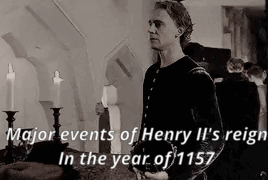





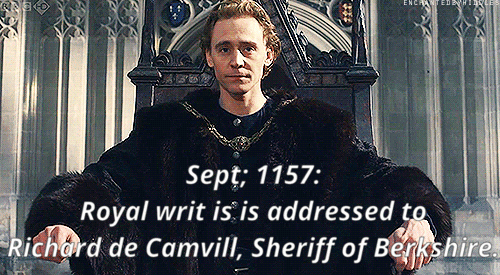

Selected events of Henry II’s reign. A.D. 1157.
Jan-March: During the King's stay in Normandy, Louis seems to have held a Court at Orleans, whereat he publicly recognized the right of Henry II., as Comte of Anjou and Seneschal of France, to custody of the Abbey of St. Julian at Tours. Among the witnesses of Louis's declaration were, Joscius, Archbishop of Tours (who appears to Vaiognes. have contested the matter previously) ; Philip, brother of the French King ; William fitz Hamo ; Robert de Novo Burgo; and Hugh de Cleeriis.
Feb. The Queen and her children leave Normandy, land at Southampton, and proceed to London. Hence at Michaelmas, 11.57, the Fermor of Southampton charges :
July. It was now probably that Malcolm, King of Scots, surrendered Bamborough, Newcastle, and Carlisle to the King. Malcolm seems to have passed through Yorkshire, Lincolnshire, and Nottinghamshire, and to have awaited King Henry at Peak Castle, in Derbyshire, and thence to Peak castle. have accompanied the King to Chester.
The King invades North Wales. The English army Chester falls into an ambuscade near Basingwerk (at Counsylth).Eustace fitz John and Robert de Courci were slain. Henry de Essex, Constable of England, disgraced himself (as was afterwards alleged) by personal cowardice. With reference to this Welsh expedition, there are many entries on the Pipe-Roll of the following Michaelmas.
Sept. Royal Writ, ascribed to this year, and probably belonging to the month of September, is addressed to Richard de Camvill, Sheriff of Berkshire (whose term of office expired at Michaelmas, 1157). It is in favour of Abingdon Abbey. It is dated at Windsor, and attested, singly, by Earl Reginald (of Cornwall). A Royal Charter, dated at Woodstock, confirms an agreement made between William Woodstock.fitz Gilbert and the Monks of Furness Abbey (Lancashire).
The witnesses (chiefly north-countrymen) are Hugh, Bishop of Durham ; Robert, Bishop of Lincoln ; Robert, Earl of Leicester ; Richard de Luci, William de Vesci, Geoffrey de Valoniis, William de Agremont, Aubert de Grellei, John Constable, Henry fitz Suan, Gospatric fitz Orm, Richard fitz Ivo, and Richard Pincerna. This Charter is expressed to be expedited 'per rnanus Stephani Capellani,'—a Vice- Chancellor, who will afterwards appear in a like capacity as 'Magister Stephanies de Ftdgeriis, Prcecentor of Moretain.
Queen Eleanor gives birth to a son, Richard, at Oxford. Hence at Michaelmas, 1157, the Sheriff of Oxfordshire charges: In corredlo Regince.
Source: Court, Household and Itinerary of K. Henry II
Fancast: Tom Hiddleston as Henry II and Jodie Corner as Eleanor of Aquitaine. Chris Pine as King Malcomn of Scotland; Johnattan Rhys-Meyers as King Louis VII of France.
#be noticed I don't own any gifs#I wanted only to make the story seen#henry ii of england#king henry ii of england#henry fitzempress#henry ii#henry curtmantle#tom hiddleston#jodie comer#queen eleanor#eleanor d'aquitaine#aliénora d'aquitaine#eleanor of aquitaine#richard i#richard lionheart#house of plantagenet#house of anjou#plantagenet#plantagenets#plantagenet dynasty#medieval england#louis vii of france#louis vii#johnattan rhys-meyers#chris pine#malcomn of scotland
19 notes
·
View notes
Text
The Siege of Beauvais in 1472.
The siege of Beauvais, in 1472, is a military operation by Charles the Bold, Duke of Burgundy, against the king of France, Louis XI.

Louis XI vs Charles the Bold (the Reckless)
The Peace of Péronne of 1468 between the king and the duke is broken, the latter accusing Louis XI of having poisoned Charles of France, duke of Guyenne, the king's own brother. The Bold takes up arms to go to Normandy to find his ally François II, Duke of Brittany.
He leaves Arras on June 14, 1472 at the head of 80,000 men, crosses the Somme, and begins to sack the region of Vermandois, the country is ablaze. The population of the city of Nesles is slaughtered.
The Burgundian avant-garde, commanded by Philippe de Crèvecoeur and Jacques de Montmartin, arrives in the morning of June 27 in front of the city of Beauvais. It is seen by roofing workers who worked on the roof of the cathedral (it will be briefly, in the 16th century, the tallest human construction in the world) and raise the alarm.

The Constable of Beauvais is then traveling and the city, without military resources. The Beauvaisiens know that they cannot endure a siege for a long time.
A Burgundian herald summons the city to surrender, to save their life . But refugee peasants from neighboring villages tell such horrible things about the Burgundians and what they have done that the city even refuses to parley.
Captain Louis de Gomel, Lord of Balagny, and his lieutenant Jean Legoy decide to take up arms. And behind them the people and the bourgeois turn into piqueurs, archers, arquebusiers, or halberdiers. Everyone runs to the ramparts.
The Burgundians launch 100 spears and 300 archers against Fort Deloy, held by fifteen arquebusiers commanded by Louis de Gomel. Despite incredible efforts on the part of the besiegers, the fort resists, although, exhausted, crushed by the number, the defenders withdraw into the city.
The Burgundians enter the suburb of Saint-Quentin, start to cry victory, and to plunder the houses, but receive a rain of arrows and are dismayed to see, a little further, the walls of the city and the Porte du Limaçon .
Once back from their surprise, they resume their assault, until around 9 o'clock in the evening. The Beauvaisiens fiercely defend themselves, slaying many Burgundians with their bows, crossbows and couleuvrines, and losing only one man.

Using a couleuvrine
Meanwhile, at the Porte de Bresles, Philippe de Crèvecoeur leads another assault, but there too, the attempts are repelled. The women of Beauvais continue to bring to the defenders murderous projectiles.
Pointing two cannons at the door, the Burgundians open a huge breach, but fail to rush into it.
On the defenders' side, Louis de Gomel is seriously injured. This does not prevent him from continuing to exhort the inhabitants and to command the defense.
Attacks follow one after the other, and Crèvecoeur asks the Duke of Burgundy for help. We have to do away with this city!
The Beauvaisiens are throwing flaming fagots on anyone who tries to force the passage; fire spreads to the door and the portcullis: the attackers are forced to withdraw.
Enters Charles the Bold. The city will be taken, he thinks, as soon as the fire is out. Not anytime soon, the locals think, who are keeping the fire going with the wood coming from the neighboring houses, while the carpenters wall the interior doorway.
The besieged must fight against the Duke's whole army. Luckily, the Lord of Troissereux, who has left Beauvais in the morning for Noyon to find help there, arrives with some lords and 200 royal lancers, and heads with them to the Porte de Bresle to repel the Burgundian assaults.
That evening, the besiegers settle in trenches, in nearby abbeys and suburbs ... over an area of 20 kilometers.
Bishop Jean de Bar manages to escape from Beauvais to run to Paris asking for help.
He will have it. The king is then busy himself against the duke of Brittany and his troops, but orders are given so that help is sent to Beauvais.
On June 28, the Marshal of France, Joachim Rouhault, lord of Gamaches, arrives in Beauvais and takes command of the place. On the 29th, Marshal André de Laval, the Seneschal of Poitou, the Seneschal of Carcassonne, of Toulouse, the Sieur de Torcy and the nobility of Normandy, the Provost of Paris with the nobility of the city, the captain of the Amiens garrison arrives with 120 men, etc ... On July 7, 600 archers from Saint-Quentin arrive in Beauvais.
The fight is tough. On June 30, Burgundy spies set fire to three different places in the city. The inhabitants extinguish them after 8 hours of struggle.
The Bold begins to work on a proper siege, drying the moats of the city, diverting the course of the Thérain river, digging mines.
On July 9, the Duke resumes the assault, immediately greeted by salvos of cannons from couleuvrines and serpentines. The whole population is there, especially the women, welcoming the Burgundians with large stones, quicklime, boiling oil, melted fat, hot ashes. It is a massacre around the breach.

That day, something happens that remains famous to this day.
Jeanne Laisné, a young resident of the city, grabs an ax to repel a Burgundian who jumped from his assault ladder to plant his flag on the ramparts. She throws herself on him and throws him down into the moats, then, says the legend, slices the flagpole with a blow of an ax, invigorating the spirit of resistance of the inhabitants. She will earn that day the nickname of Jeanne Hachette (the Hatchet).

After 3 hours of a fierce struggle, Charles the Bold, seeing that he is getting nowhere, stops the attack.
On July 10, 300 to 400 inhabitants accompanied by fifteen horsemen make an outing in the Burgundian camp, without much success even if they kill some soldiers and bring back 2 guns into the city.
This expedition is followed by several others, always fatal to the besiegers. The duke may send other spies to burn down the city, they are caught and beheaded.
After 24 days of siege, the Bold breaks camp, burning villages over 20 km around. He will not have succeeded in taking Beauvais.
In his movement towards Rouen where he intends to find the army of Brittany, he ravages the rich Pays of Caux, burns and takes Eu and Saint-Valéry-en-Caux, but fails in front of Dieppe, one of the strongest cities of the kingdom. He spends 4 days in front of Rouen.
The city is well fortified and entrenched. Antoine de Chabannes' troops continually harass those of the Bold. And then the Burgundian army suffers from hunger and illness. And the soldiers don't get their pay.
Charles the Bold, in his retreat, once again wreaks bloody havoc.
Very quickly, the king's troops retake the only two cities he took, Eu and Saint-Valéry. The Duke is still harassed by Chabannes and the constable, who refuse to fight: the incessant skirmishes finish demoralizing an army exasperated by famine and disease.
The city of Beauvais was particularly rescued by Paris, which hurriedly sent a large number of artillery pieces, couleuvrines, crossbowmen, gunners, pioneers and food in abundance.
Rouen also sent pioneers, crossbowmen, masons and carpenters, Orléans sent large quantities of wine. The Pays of Caux is completely ravaged by the chevauchée, but Charles the Bold suffers a terrible humiliation.
The royal army has managed to cut the supply lines of the Burgundians and the reinforcements were very well organized by order of the king. However, this siege pointed out and proved that the bourgeois, especially the women, were indeed able to defend a royal city with their courage, because the city of Beauvais had had to defend itself for a long time.
King Louis XI will show his gratitude to his good city of Beauvais. Jeanne marries the man she loves, both will be exempt from taxes for life, and an annual procession, the Procession of the Assault, will celebrate her deed, opened by the women of the city. In 1851, a statue was erected in honor of Jeanne Hachette.

When the Germans melted down the statues of the city as in many cities in France, leaving the inhabitants the right to keep only one, they chose to save Jeanne's statue.
Today, the Assault procession still takes place, in period costumes.



#xv#charles le téméraire#jeanne hachette#siège de beauvais#louis xi#today in history#the struggle against the house of burgundy#beauvais
19 notes
·
View notes
Text
Monarch #7
Who: Æthelred II (Old English: Æþelræd) Also Known As: Æthelred the Unready (his epithet does not derive from the modern word "unready", but rather from the Old English unræd meaning "poorly advised"; it is a pun on his name, which means "well-advised") Where: England Succeeded: His brother, Edward Reigned: 978-1013 and again from 1014-1016 Born: c.966 Died: 23rd April, 1016 (aged around 50), London Buried: Old St Paul’s Cathedral, London (lost) Consorts/Children: First married Ælfgifu of York, sometime in the mid-980s, and she was definitely dead by 1002. With Æthelred she had at least nine children, possibly ten. Second, he married Emma of Normandy in 1002, with whom he had three children.
Æthelred Facts! Æthelred’s (combined) reign of 37 years was the longest of any Anglo-Saxon king of England, and was only surpassed in the 13th century by Henry III.
He came to the throne aged 12, after his mother may or may not have had his older half-brother, Edward, murdered. It’s pretty much accepted that he was far too young to have been involved.
This is the moment that the Danish started being seriously problematic. After decades of more-or-less peace, the Danish raids restarted in 980 and how. After the Battle of Maldon in 991, Æthelred paid tribute to the Danish king called Danegeld, intended to bribe him into going the heck away.
This didn’t work. So, in 1002, Æthelred ordered the massacre of Danish settlers in what became known as the St Brice’s Day massacre. Supposed amongst the killed is Gunhilde, the sister of Sweyn Forkbeard, the King of Denmark. Æthelred justified the massacre in a royal charter of 1004, explaining the need to rebuild Saint Frideswide’s church[1].
Gunhilde may or may not have died then, but it was given as a justification of Sweyn’s invasion of England in 1013 (maybe it took nine years for him to build up both an army and a really good snit over it). Æthelred ran away to Normandy, and Sweyn Forkbeard ruled for a few months before dying. Æthelred then came back and ruled until he died, two years later.
Æthelred has been credited with the formation of a local investigative body made up of twelve thegns who were charged with publishing the names of any notorious or wicked men in their respective districts. Because the members of these bodies were under solemn oath to act in accordance with the law and their own good consciences, they have been seen by some legal historians as the prototype for the English grand jury. Æthelred makes provision for such a body in a law code he enacted at Wantage in 997, which states:
that there shall be an assembly in every wapentake,[n 4] and in that assembly shall go forth the twelve eldest thegns and the reeve along with them, and let them swear on holy relics, which shall be placed in their hands, that they will never knowingly accuse an innocent man nor conceal a guilty man. And thereafter let them seize those notorious [lit. "charge-laden"] men, who have business with the reeve, and let each of them give a security of 6 half-marks, half of which shall go to the lord of that district, and half to the wapentake.[3]
The Anglo-Saxon Chronicle is incredibly critical of Æthelred, but was written in retrospect and could be seen as to be judging his policies and actions with the foregone conclusion that he was always doomed to lose to the Danish. There have been some arguments in favour of Æthelred made, and indeed recent assessments have cautiously come down in favour of him. "Æthelred's misfortune as a ruler was owed not so much to any supposed defects of his imagined character, as to a combination of circumstances which anyone would have found difficult to control.”[4]
Ælfgifu of York Facts! We think she was born in the 970s and died before 1002, when Æthelred remarried. She might have been the daughter of Thored, the Earl of southern Northumbria. The problem here is that what we know of her comes from sources written in the 1080s and afterwards. The first (from Sulcard of Winchester) describes her as being “of very noble English stock” but declines to name her. William of Malmesbury, writing in the 12th century has nothing to say of her at all, whilst in the 1150s, Ailred of Rievaulx notes her as the daughter of Thored and mother of Edmund, but again does not name her. Even though he was writing so late, he was the seneschal at the court of the Scottish king David I, whose mother Margerat was the great-granddaugther of Ælfgifu and his information may have come to him through genuine sources. And that is pretty much all we know about her, apart from the names of her children. Even her date of birth and the date of her marriage is supposed based on what we know about her sons. Of her daughters we have very little information, even some of their names are vague, and there is one who is posited, unnamed, and cannot be confirmed.
Æthelstan Ætheling (died 1014)
Ecgberht Ætheling (died c. 1005)[40]
Edmund Ironside (King of England, died 1016)
Eadred Ætheling (died before 1013)
Eadwig Ætheling (executed by Cnut 1017)
Edgar Ætheling (died c. 1008)
Eadgyth or Edith (married Eadric Streona) v
Wulfhild? (married Ulfcytel Snillingr)
Abbess of Wherwell Abbey?
Emma of Normandy Facts! As queen of England, Emma wasn’t allowed to be called Emma. She was Ælfgifu in official royal documents.
She was the daughter of Duke Richard I of Normandy and his wife, Gunnor (also called Gunnora).
Her first marriage, to Ælthelred, was made in order to keep relations between Normandy and England cordial. Things had been going downhill after Richard II of Normandy, Emma’s brother, welcomed Danish Vikings to the dukedom and gave them sanctuary, violating a treaty between Æthelred and Richard I, wherein the duke had sworn not to aid the enemies of England after he too had been giving the Danes assistance.
During the Danish invasion by Sweyn Forkbeard, Emma and her children were sent to Normandy, where Æthelred soon followed, but they all came back after Sweyn died.
Little is written of Emma during this time but she’s going to come up again later, because she didn’t stay a dowager queen for too much longer. She married Cnut in 1017.
She had three children with Æthelred:
Edward the Confessor c. 1003 – 5 January 1066
Goda of England c.1004 – c.1049
Alfred the Noble c. 1005–1036
[1] "For it is fully agreed that to all dwelling in this country it will be well known that, since a decree was sent out by me with the counsel of my leading men and magnates, to the effect that all the Danes who had sprung up in this island, sprouting like cockle amongst the wheat, were to be destroyed by a most just extermination, and thus this decree was to be put into effect even as far as death, those Danes who dwelt in the afore-mentioned town, striving to escape death, entered this sanctuary of Christ, having broken by force the doors and bolts, and resolved to make refuge and defence for themselves therein against the people of the town and the suburbs; but when all the people in pursuit strove, forced by necessity, to drive them out, and could not, they set fire to the planks and burnt, as it seems, this church with its ornaments and its books. Afterwards, with God's aid, it was renewed by me."
[2]Wormald, Patrick (1978), "Aethelred the lawmaker", in David Hill (ed.), Ethelred the Unready: Papers from the Millenary Conference, British Archaeological Reports - British Series 59, pp. 47–80
[3]Liebermann, Felix (1903). Die Gesetze der Angelsachsen: in der Ursprache mit Uebersetzung und Erläuterungen. Volume 1. Halle a.S.: Max Niemeyer.
[4]Keynes, Simon (1986). "A Tale of Two Kings: Alfred the Great and Æthelred the Unready". Transactions of the Royal Historical Society. Fifth Series 36. 36: 195–217
#Ethelred the Unready#Æthelred II#Æthelred the Unready#Æthelred#kings of england#queens of england#emma of normandy#Ælfgifu of York#monarchs#monarchy
2 notes
·
View notes
Photo

“25th June 1014 saw the death of Æþelstan Æþeling, the eldest son of Æþelred II UnRede and Ælfgifu, his first wife whom he married around 985 AD. He was also the full brother of Edmund Ironside.
Little is known of him, although he witnessed a charter in 993 AD, presumably still a child. However, his will has survived and provides an insight into the household of an æþeling as well as Æþelstan’s personal friendships and loyalties. For instance in the will he prays for the soul of his grandmother who brought him up; this was Ælfthryth, wife of Edgar and mother of both Æþelred the King and his murdered brother Edward the Martyr. Her involvement in that murder remains a hot topic of debate to this day, but at least her eldest grandson held her in affection.
In 1013 his father had been driven out of his kingdom by Sweyn Forkbeard and gone into exile in Normandy. Where his eldest sons were at the time is not clear but it is possible they remained in England. Sweyn died on 3rd February 1014 and Æþelred returned to his throne, promising to rule better in a detailed agreement which is the first recorded pact between a King and his subjects.
In Æþelstan’s will, copies of which still survive, and which was made on the day of his death, his first bequest was the manumission of “every penally enslaved man whom I obtained through litigation;” and he gave large amounts of property to the church. The Holy Cross and St Edward the Martyr at Shaftesbury received six pounds, Edward being his uncle murdered by on or behalf of his father to secure his accession to the throne.
Æthelstan is often described as a "warrior prince" because by his death he had accumulated a large collection of swords, prized war horses and combat equipment. He left Edmund Ironside his most prized possession, a sword which had once belonged to Offa of Mercia, together with some of his estates and other pieces of his war gear.
To his other full brother, Eadwig, he gave another piece from his large weapon collection, a silver-hilted sword. Members of his household also benefited: his chaplain, his seneschal, his retainers (cnihtas), his sword-sharpener and his stag huntsman. He also remembered three thegns of the Danelaw, Sigeferth, Morcar and Thurbrand the Hold.
His mother had been the daughter of Earl Thored of Northumbria, although she is not mentioned in the will despite mentions of his father, grandmother and foster-mother. Neither does he mention his step-mother of half-brothers, so a family split has been perceived.
Another beneficiary was Godwin, son of Wulfnoþ, and who is believed to be the same person as Godwin, Earl of Wessex and father of Harold. He was bequeathed an estate at Compton in Sussex, which had originally belonged to his father.
Æþelstan’s estates were widespread in Oxfordshire, Buckinghamshire, Cambridgeshire, Derbyshire, Bedfordshire, Hertfordshire, Hampshire, Wiltshire and Kent.
He was buried at the Old Minster, Winchester.”
All due credits go to facebook page “Anglo-Saxon History in Yorkshire”.
#anglo-saxons#Aethelstan#Aethelred the unready#Aethelred II#Edmund Ironside#primary source#medieval#middle ages#england 11th century
6 notes
·
View notes
Text
the alchemical wedding: chapter seven

Summary: Discovery of Witches AU. When Dr. Lucy Preston, historian and reluctant witch, stumbles on an enchanted alchemical manuscript, Ashmole 782, in Oxford University’s Bodleian Library, she crosses paths with the mysterious vampire Garcia Flynn. They must work together to discover its secrets, their conflicted family legacies, and the shadowy enemies who want to claim it. As they do, they are increasingly and unwillingly drawn to each other, but that may be the most dangerous and forbidden magic of all. Rating: M Status: WIP Previous: Friggin’ Twilight
Chapter Seven: Sept-Tours
The next several hours are a blur. At least the fact of having come directly from Woodstock means that they still have Lucy’s things and don’t need to make a very risky trip back to her flat, and Flynn really wants to get out of here. He keeps looking over his shoulder, staring evilly after presumably innocent passersby, and it is not long later when he has bundled the still-shocked Lucy into the car and they are driving back up the A44 anyway, in the direction of Oxford Airport. Jiya has come with them so she can take the car home, but she keeps throwing dark looks at Flynn from the passenger seat. Finally, as they’re about to turn into the airfield, she mutters, “Do you really think this is a good idea? Taking her to Sept-Tours? Grand-mère is not going to like this.”
“It’ll be fine.” Flynn is, of course, well aware of his mother’s feelings on witches, some of which he was just explaining to Lucy the other night. “She knows what I’ve been trying to do with Ashmole 782, and she doesn’t even have to see Lucy if she doesn’t want to.”
“You’re still asking her to welcome a witch wanted by the entire creature world and hunted by the Congregation into her house,” Jiya says, low-voiced. “With no warning at all. Dad, just – call Cecilia ahead of time or something, okay? Please.”
Flynn utters an impatient noise in his throat, even as he knows this suggestion is made with preventive intent. Cecilia is, apart from Houdini, the de Clermont family’s other long-term servant. She’s from eleventh-century Normandy and still mostly only speaks Old French, pretending not to understand when anyone addresses her in “that slang,” but she has lived as Sept-Tours’ chatelaine, seneschal, and general manager of the estate for centuries, and is, if nothing else, used to interceding with Maria de Clermont on behalf of her idiot sons. Cecilia is formidable and sharp-tongued (she used to be an abbess at Holy-Trinity in Caen, and Flynn can imagine her absolutely terrifying the novices), but she is fond of the boys, and will probably at least prepare the way. So much as it can be prepared at all.
“I’ll call her once we’re en route,” Flynn says at last. “See if she can have a car waiting at Poitiers. But still – ”
“Just don’t walk up the drive with Lucy for the first time and spring it on Grand-mère like that, all right? Are you sure you couldn’t do this in Woodstock?”
“Yes.” Flynn accelerates through the automatic barrier and looks around for the car park. “It’s too close to Oxford, all the hornets’ nests have been kicked, and all my archived work is at Sept-Tours. Besides, it’s the one place the Congregation or anyone else absolutely won’t dare to go. I can’t get this finished if I’m keeping one eye on Lucy the whole time.”
“She just conjured witch-wind, from what you said,” Jiya counters. “Are you sure she really needs your help?”
Flynn has the distinct feeling that this is offered as a condemnation of his help, rather than high praise of Lucy’s novice abilities or any suggestion that she should actually be left on her own, and settles for an affronted harrumph. They turn into an empty bay, he parks, takes out the keys, and tosses them to Jiya. She is wearing the expression that means she suspects her advice has gone in one ear and directly out the other, and slides over into the driver’s seat. “At least text me when you get there and nobody’s dead, all right?”
Flynn agrees, opens the back door, and shows Lucy out, as she grabs her bag and gives him a worried look that might suggest she did in fact overhear all that. “Is everything going to be all right with this? I mean, I’m a witch, and you said your mother hated witches.”
[read the rest on AO3]
17 notes
·
View notes
Photo










Man's Impact on the Environment Château de Carrouges Carrouges, Orne département, Normandy, France
The castle of Carrouges is a castle of the fourteenth century located in the Normandy region , in the French department of Orne , in the town of Carrouges .
Managed by the center of national monuments , it is the subject of a classification as historical monuments since the December 6 , 1927
First defensive oppidum (stronghold in height) located on the southern border of the Norman duchy of William the Conqueror , vainly besieged by the Plantagenet in 1136 and destroyed at the beginning of the Hundred Years War , it was rebuilt in the valley in the middle ponds between Maine and Normandy by the lords of Carrouges who were confiscated for insurrection by the King of England. Jean de Carrouges (IV), at the origin of the castle which remains the dungeon , was chamberlain of the count Pierre II d ' Alençon and became knight of honor of the king Charles VI following a judicial duel where he had put in play his life to save his honor and that of his wife Marguerite de Thibouville, who was raped during his absence. He and his heirs will stand alongside the kings of France for the duration of the Hundred Years War and help to drive the British out of the kingdom.
The history of the Carrouges Castle continues until the twentieth century. First became a stronghold besieged by the Plantagenets and rebuilt after the Hundred Years War , the new castle was rebuilt in the fifteenth century by Jean Blosset, lord of the place and grand seneschal of Normandy , who added to the original elements a complete wing. Jean Blosset built, on the prayers of his wife Marguerite de Derval, a chapel that she wanted to place under the title of Notre-Dame-de-Bon-Confort and that he will transform into a chantry in 1493 , just after his death. This collegiate church, founded under Louis XI , now houses the headquarters of the Normandie-Maine Regional Nature Park .
Blosset having no heir, it is his sister Marie who will transmit the estate to his son Jean Le Veneur, which will adorn the building with a chatelet Louis XII style (pavilion of Cardinal Jean Le Veneur). Louis XI slept in the castle on August 11, 1473 . The buildings were remodeled several times between the fourteenth and seventeenth centuries (the pavilion of Cardinal Le Veneur, the western bastion fortified during the wars of religion , and large apartments in particular). It was refitted in the 18th century , and has a music room. It was in the sixteenth century that the Veneur de Tillières took possession of the estate, until 1936 , when it was sold to the State . It was restored after 1944 . Carrouges Castle became during the Grand Siècle a sumptuous residence (suite of large apartments), and remained throughout the Age of Enlightenment (music room).
8 notes
·
View notes
Text
LAW # 37 : CREATE COMPELLING SPECTACLES
JUDGEMENT
Striking imagery and grand symbolic gestures create the aura of power—everyone responds to them. Stage spectacles for those around you, then, full of arresting visuals and radiant symbols that heighten your presence. Dazzled by appearances, no one will notice what you are really doing.
ANTONY AND CLEOPATHA
She relied above all upon her physical presence and the spell and enchantment which it could create.... She came sailing up the river Cydnus in a barge with a poop of gold, its purple sails billowing in the wind, while her rowers caressed the water with oars of silver which dipped in time to the music of the flute, accompanied by pipes and lutes. Cleopatra herself reclined beneath a canopy of cloth of gold, dressed in the character of Aphrodite, as we see her in paintings, while on either side to complete the picture stood boys costumed as Cupids who cooled her with their fans. Instead of a crew the barge was lined with the most beautiful of her waiting-women attired as Nereids and Graces, some at the rudders, others at the tackle of the sails, and all the while an indescribably rich perfume, exhaled from innumerable censers, was wafted from the vessel to the riverbanks. Great multitudes accompanied this royal progress, some of them following the queen on both sides of the river from its very mouth, while others hurried down from the city of Tarsus to gaze at the sight. Gradually the crowds drifted away from the marketplace, where Antony awaited the queen enthroned on his tribunal, until at last he was left sitting quite alone. And the word spread on every side that Aphrodite had come to revel with Dionysus for the happiness of Asia. Antony then sent a message inviting Cleopatra to dine with him. But she thought it more appropriate that he should come to her, and so, as he wished to show his courtesy and goodwill, he accepted and went. He found the preparations made to receive him magnificent beyond words, but what astonished him most of all was the extraordinary number of lights. So many of these, it is said, were let down from the roof and displayed on all sides at once, and they were arranged and grouped in such ingenious patterns in relation to each other, some in squares and some in circles, that they created as brilliant a spectacle as can ever have been devised to delight the eve.
LIFE OF ANTONY. PLUTARCH. C. A.D. 46-120
OBSERVANCE OF THE LAW I
In the early 1780s, word spread through Berlin of the strange and spectacular medical practice of a Dr. Weisleder. He performed his miracles in an enormous converted beer hall, outside which Berliners began to notice ever longer lines of people—the blind, the lame, anyone with an illness incurable by normal medicine. When it leaked out that the doctor worked by exposing the patient to the rays of the moon, he soon became dubbed The Moon Doctor of Berlin.
Sometime in 1783, it was reported that Dr. Weisleder had cured a well-to-do woman of a terrible ailment. He suddenly became a celebrity. Previously only the poorest Berliners had been seen waiting outside the beer hall in their rags; now magnificent carriages were parked outside, and gentlemen in frock coats, and ladies with enormous coiffures, lined the street as sunset drew near. Even folk with the mildest of ailments came, out of sheer curiosity. As they waited in line, the poorer clients would explain to the gentlemen and ladies that the doctor only practiced when the moon was in its increscent phase. Many would add that they themselves had already been exposed to the healing powers he called forth from the rays of the moon. Even those who felt cured kept coming back, drawn by this powerful experience.
Inside the beer hall, a strange and stirring spectacle greeted the visitor: Packed into the entrance hall was a crowd of all classes and ethnic backgrounds, a veritable Tower of Babel. Through tall windows on the northern side of the hall, silvery moonlight poured in at odd angles. The doctor and his wife, who, it seemed, was also able to effect the cure, practiced on the second floor, which was reached by a stairway, at the end of the hall. As the line edged closer to the stairs, the sick would hear shouts and cries from above, and word would spread of, perhaps, a blind gentleman suddenly able to see.
Once upstairs, the line would fork in two directions, toward a northern room for the doctor, a southern one for his wife, who worked only on the ladies. Finally, after hours of anticipation and waiting in line, the gentlemen patients would be led before the amazing doctor himself, an elderly man with a few stalks of wild gray hair and an air of nervous energy. He would take the patient (let us say a young boy, brought in by his father), uncover the afflicted body part, and lift the boy up to the window, which faced the light of the moon. He would rub the site of the injury or illness, mumble something unintelligible, look knowingly at the moon, and then, after collecting his fee, send the boy and his father on their way. Meanwhile, in the south-facing room, his wife would be doing the same with the ladies—which was odd, really, since the moon cannot appear in two places at once; it cannot have been visible, in other words, from both windows. Apparently the mere thought, idea, and symbol of the moon were enough, for the ladies did not complain, and would later remark confidently that the wife of the Moon Doctor had the same healing powers as he.
Interpretation
Dr. Weisleder may have known nothing about medicine, but he understood human nature. He recognized that people do not always want words, or rational explanations, or demonstrations of the powers of science; they want an immediate appeal to their emotions. Give them that and they will do the rest—such as imagine they can be healed by the light reflected from a rock a quarter million miles away. Dr. Weisleder had no need of pills, or of lengthy lectures on the moon’s power, or of any silly gadgetry to amplify its rays. He understood that the simpler the spectacle the better—just the moonlight pouring in from the side, the stairway leading to the heavens, and the rays of the moon, whether directly visible or not. Any added effects might have made it seem that the moon was not strong enough on its own. And the moon was strong enough—it was a magnet for fantasies, as it has been throughout history. Simply by associating himself with the image of the moon, the doctor gained power.
Remember: Your search for power depends on shortcuts. You must always circumvent people’s suspicions, their perverse desire to resist your will. Images are an extremely effective shortcut: Bypassing the head, the seat of doubt and resistance, they aim straight for the heart. Overwhelming the eyes, they create powerful associations, bringing people together and stirring their emotions. With the white light of the moon in their eyes, your targets are blinded to the deceptions you practice.
OBSERVANCE OF THE LAW II
In 1536 the future king Henri II of France took his first mistress, Diane de Poitiers. Diane was thirty-seven at the time, and was the widow of the grand seneschal of Normandy. Henri, meanwhile, was a sprightly lad of seventeen, who was just beginning to sow his wild oats. At first their union seemed merely platonic, with Henri showing an intensely spiritual devotion to Diane. But it soon became clear that he loved her in every way, preferring her bed to that of his young wife, Catherine de’ Médicis.
In 1547 King Francis died and Henri ascended to the throne. This new situation posed perils for Diane de Poitiers. She had just turned forty-eight, and despite her notorious cold baths and rumored youth potions, she was beginning to show her age; now that Henri was king, perhaps he would return to the queen’s bed, and do as other kings had done—choose mistresses from the bevy of beauties who made the French court the envy of Europe. He was, after all, only twenty-eight, and cut a dashing figure. But Diane did not give up so easily. She would continue to enthrall her lover, as she had enthralled him for the past eleven years.
In the Middle Ages the symbolist attitude was much more in evidence. ... Symbolism appears as a sort of short cut of thought. Instead of looking for the relation between two things by following the hidden detours of their causal connexions, thought makes a leap and discovers their relation not in the connexion of cause and effects, but in a connexion of signification.... Symbolist thought permits an infinity of relations between things. Each thing may denote a number of distinct ideas by its different special qualities, and a quality may have several symbolic meanings. The highest conceptions have symbols by the thousand. Nothing is too humble to represent and glory the sublime. The walnut signifies Christ: the sweet kernel is His divine nature, the green and pulpy outer peel is His humanity, the wooden shell between is the cross. Thus all things raise his thoughts to the eternal.... Every precious stone, besides its natural splendour sparkles with the brilliance of its symbolic values. The assimilation of roses and virginity is much more than a poetic comparison, for it reveals their common essence. As each notion arises in the mind the logic of symbolism creates an harmony of ideas.
THE WANING OF THE MIDDLE AGES, JOHAN HUIZINGA, 1928
Diane’s secret weapons were symbols and images, to which she had always paid great attention. Early on in her relationship with Henri, she had created a motif by intertwining her initials with his, to symbolize their union. The idea worked like a charm: Henri put this insignia everywhere—on his royal robes, on monuments, on churches, on the facade of the Louvre, then the royal palace in Paris. Diane’s favorite colors were black and white, which she wore exclusively, and wherever it was possible the insignia appeared in these colors. Everyone recognized the symbol and its meaning. Soon after Henri took the throne, however, Diane went still further: She decided to identify herself with the Roman goddess Diana, her namesake. Diana was the goddess of the hunt, the traditional royal pastime and the particular passion of Henri. Equally important, in Renaissance art she symbolized chastity and purity. For a woman like Diane to identify herself with this goddess would instantly call up those images in the court, giving her an air of respectability. Symbolizing her “chaste” relationship with Henri, it would also set her apart from the adulterous liaisons of royal mistresses past.
To effect this association, Diane began by completely transforming her castle at Anet. She razed the building’s structure and in its place erected a magnificent Doric-columned edifice modeled after a Roman temple. It was made in white Normandy stone flecked with black silex, reproducing Diane’s trademark colors of black and white. The insignia of her and Henri’s initials appeared on the columns, the doors, the windows, the carpet. Meanwhile, symbols of Diana—crescent moons, stags, and hounds—adorned the gates and facade. Inside, enormous tapestries depicting episodes in the life of the goddess lay on the floors and hung on the walls. In the garden stood the famous Goujon sculpture Diane Chasseresse, which is now in the Louvre, and which had an uncanny resemblance to Diane de Poitiers. Paintings and other depictions of Diana appeared in every corner of the castle.
Anet overwhelmed Henri, who soon was trumpeting the image of Diane de Poitiers as a Roman goddess. In 1548, when the couple appeared together in Lyons for a royal celebration, the townspeople welcomed them with a tableau vivant depicting a scene with Diana the huntress. France’s greatest poet of the period, Pierre de Ronsard, began to write verses in honor of Diana—indeed a kind of cult of Diana sprang up, all inspired by the king’s mistress. It seemed to Henri that Diane had given herself a kind of divine aura, and as if he were destined to worship her for the rest of his life. And until his death, in 1559, he did remain faithful to her—making her a duchess, giving her untold wealth, and displaying an almost religious devotion to his first and only mistress.
Interpretation
Diane de Poitiers, a woman from a modest bourgeois background, managed to captivate Henri for over twenty years. By the time he died she was well into her sixties, yet his passion for her only increased with the years. She knew the king well. He was not an intellectual but a lover of the outdoors—he particularly loved jousting tournaments, with their bright pennants, brilliantly caparisoned horses, and beautifully dressed women. Henri’s love of visual splendor seemed childlike to Diane, and she played on this weakness of his at every opportunity.
Most astute of all was Diane’s appropriation of the goddess Diana. Here she took the game beyond physical imagery into the realm of the psychic symbol. It was quite a feat to transform a king’s mistress into an emblem of power and purity, but she managed it. Without the resonance of the goddess, Diane was merely an aging courtesan. With the imagery and symbolism of Diana on her shoulders, she seemed a mythic force, destined for greatness.
You too can play with images like these, weaving visual clues into an encompassing gestalt, as Diane did with her colors and her insignia. Establish a trademark like these to set yourself apart. Then take the game further: Find an image or symbol from the past that will neatly fit your situation, and put it on your shoulders like a cape. It will make you seem larger than life.
There was a man named Sakamotoya Hechigwan who lived in upper Kyoto.... When [Emperor] Hideyoshi gave his great Cha-no-yu [tea ceremony] meeting at Kitano in the tenth month of 1588, Hechigwan set up a great red umbrella nine feet across mounted on a stick seven feet high. The circumference of the handle he surrounded for about two feet by a reed fence in such a way that the rays of the sun were reflected from it and diffused the colour of the umbrella all around. This device pleased Hideyoshi so much that he remitted Hechigwan’s taxes as a reward.
CHA-NO-YU: THE JAPANESE TEA CEREMONY, A. L. SADLER, 1962
Because of the light it shines on the other stars which make up a kind of court around it, because of the just and equal distribution of its rays to all alike, because of the good it brings to all places, producing life, joy and action, because of its constancy from which it never varies, I chose the sun as the most magnificent image to represent a great leader.
Louis XIV, the Sun King, 1638-1715
KEYS TO POWER
Using words to plead your case is risky business: Words are dangerous instruments, and often go astray. The words people use to persuade us virtually invite us to reflect on them with words of our own; we mull them over, and often end up believing the opposite of what they say. (That is part of our perverse nature.) It also happens that words offend us, stirring up associations unintended by the speaker.
The visual, on the other hand, short-circuits the labyrinth of words. It strikes with an emotional power and immediacy that leave no gaps for reflection and doubt. Like music, it leaps right over rational, reasonable thoughts. Imagine the Moon Doctor trying to make a case for his medical practice, trying to convince the unconverted by telling them about the healing powers of the moon, and about his own special connection to a distant object in the sky. Fortunately for him, he was able to create a compelling spectacle that made words unnecessary. The moment his patients entered the beer hall, the image of the moon spoke eloquently enough.
Understand: Words put you on the defensive. If you have to explain yourself your power is already in question. The image, on the other hand, imposes itself as a given. It discourages questions, creates forceful associations, resists unintended interpretations, communicates instantly, and forges bonds that transcend social differences. Words stir up arguments and divisions; images bring people together. They are the quintessential instruments of power.
The symbol has the same force, whether it is visual (the statue of Diana) or a verbal description of something visual (the words “the Sun King”). The symbolic object stands for something else, something abstract (such as the image “Diana” standing for chastity). The abstract concept—purity, patriotism, courage, love—is full of emotional and powerful associations. The symbol is a shortcut of expression, containing dozens of meanings in one simple phrase or object. The symbol of the Sun King, as explained by Louis XIV, can be read on many layers, but the beauty of it is that its associations required no explanation, spoke immediately to his subjects, distinguished him from all other kings, and conjured up a kind of majesty that went far beyond the words themselves. The symbol contains untold power.
The first step in using symbols and images is to understand the primacy of sight among the senses. Before the Renaissance, it has been argued, sight and the other senses—taste, touch, and so on—operated on a relatively equal plane. Since then, however, the visual has come to dominate the others, and is the sense we most depend on and trust. As Gracián said, “The truth is generally seen, rarely heard.” When the Renaissance painter Fra Filippo Lippi was a captured slave among the Moors, he won his freedom by sketching a drawing of his master on a white wall with a piece of charcoal; when the owner saw the drawing, he instantly understood the power of a man who could make such images, and let Fra Lippi go. That one image was far more powerful than any argument the artist could have made with words.
Never neglect the way you arrange things visually. Factors like color, for example, have enormous symbolic resonance. When the con artist Yellow Kid Weil created a newsletter touting the phony stocks he was peddling, he called it the “Red Letter Newsletter” and had it printed, at considerable expense, in red ink. The color created a sense of urgency, power, and good fortune. Weil recognized details like these as keys to deception—as do modern advertisers and mass-marketers. If you use “gold” in the title of anything you are trying to sell, for example, print it in gold. Since the eye predominates, people will respond more to the color than to the word.
The visual contains great emotional power. The Roman emperor Constantine worshipped the sun as a god for most of his life; one day, though, he looked up at the sun, and saw a cross superimposed on it. The vision of the cross over the sun proved to him the ascendancy of the new religion, and he converted not just himself but the whole Roman Empire to Christianity soon thereafter. All the preaching and proselytizing in the world could not have been as powerful. Find and associate yourself with the images and symbols that will communicate in this immediate way today, and you will have untold power.
Most effective of all is a new combination—a fusion of images and symbols that have not been seen together before, but that through their association clearly demonstrate your new idea, message, religion. The creation of new images and symbols out of old ones in this way has a poetic effect—viewers’ associations run rampant, giving them a sense of participation.
Visual images often appear in a sequence, and the order in which they appear creates a symbol. The first to appear, for instance, symbolizes power; the image at the center seems to have central importance.
Near the end of World War II, orders came down from General Eisenhower that American troops were to lead the way into Paris after its liberation from the Nazis. The French general Charles de Gaulle, however, realized that this sequence would imply that the Americans now commanded the fate of France. Through much manipulation, de Gaulle made certain that he and the French Second Armored Division would appear at the head of the liberating force. The strategy worked: After he had successfully pulled off this stunt, the Allies started treating him as the new leader of an independent France. De Gaulle knew that a leader has to locate himself literally at the head of his troops. This visual association is crucial to the emotional response that he needs to elicit.
Things change in the game of symbols: It is probably no longer possible to pose as a “sun king,” or to wrap the mantle of Diana around you. Yet you can associate yourself with such symbols more indirectly. And, of course, you can make your own mythology out of figures from more recent history, people who are comfortably dead but still powerfully associative in the public eye. The idea is to give yourself an aura, a stature that your normal banal appearance simply will not create. By herself Diane de Poitiers had no such radiant powers; she was as human and ordinary as most of us. But the symbol elevated her above the human lot, and made her seem divine.
Using symbols also has a courtier-like effect, since they are often gentler than brutish words. The psychotherapist Dr. Milton H. Erickson always tried to find symbols and images that would communicate to the patient in ways that words could not. When dealing with a severely troubled patient, he would not question him directly but would talk about something irrelevant, such as driving through the desert in Arizona, where he practiced in the 1950s. In describing this he would eventually come to an appropriate symbol for what he suspected was the man’s problem. If he felt the patient was isolated, say, Dr. Erickson would talk of a single iron-wood tree, and how its isolation left it battered by the winds. Making an emotional connection with the tree as a symbol, the patient would open up more readily to the doctor’s probing.
Use the power of symbols as a way to rally, animate, and unite your troops or team. During the rebellion against the French crown in 1648, those loyal to the king disparaged the rebels by comparing them to the slingshots (in French, frondes) that little boys use to frighten big boys. Cardinal de Retz decided to turn this disparaging term into the rebels’ symbol: The uprising was now known as the Fronde, and the rebels as frondeurs. They began to wear sashes in their hats that symbolized the slingshot, and the word became their rallying cry. Without it the rebellion might well have petered out. Always find a symbol to represent your cause—the more emotional associations, the better.
The best way to use images and symbols is to organize them into a grand spectacle that awes people and distracts them from unpleasant realities. This is easy to do: People love what is grand, spectacular, and larger than life. Appeal to their emotions and they will flock to your spectacle in hordes. The visual is the easiest route to their hearts.
Image: The Cross and the Sun. Crucifixion and total radiance. With one imposed over the other, a new reality takes shape—a new power is in the ascendant. The symbol—no explanation necessary.
Authority: The people are always impressed by the superficial appearance of things.... The [prince] should, at fitting times of the year, keep the people occupied and distracted with festivities and spectacles. (Niccolò Machiavelli, 1469-1527)
REVERSAL
No power is made available by ignoring images and symbols. There is no possible reversal to this law.
26 notes
·
View notes
Text
Death of Geoffrey Plantagenet, Duke of Brittany
On this day in history in 1186, Geoffrey Plantagenet died in Paris. He was the fourth of five sons born to Henry II, King of England, and Eleanor, Duchess of Aquitaine. He died unexpectedly at the age of 27, in the prime of his life. There is also evidence that he might have died on the 21st of August, 1186.
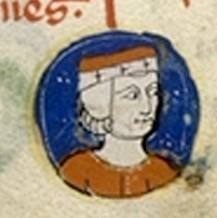
Geoffrey is one of the forgotten Angevin royals: he is rarely the focus of historians because he died young and was the only son of Henry and Eleanor who survived to adulthood, yet never wore a crown. In Angevin history, he has been called “a duke among kings.”
He was born at Beaumont Palace, Oxford. In her biography of Eleanor of Aquitaine, Marion Meade wrote of his birth:
“On September 23, 1158, without fuss or fanfare and almost seeming to be an afterthought, she [Eleanor] gave birth to another son, Geoffrey.”
Geoffrey’s Personality
There are no portraits of Geoffrey Plantagenet at any age known to exist. According to contemporary chronicles, Geoffrey was dark-haired and short of stature; he had an average appearance and was not considered good-looking, charming, or charismatic. He was probably the most intelligent son of Eleanor and Henry, but he used his talents for selfish schemes.

Geoffrey in the movie “Lion in the Winter”
It’s likely that the young Geoffrey was often overshadowed by the towering personalities which dominated the royal family. His father ruled vast lands and was one of the wealthiest and most successful kings of his time. His mother had been Queen of France before becoming Queen of England, and through the strength and determination of her personality, she maintained control over the vast, prosperous, and strategic Duchy of Aquitaine. Geoffrey’s two older brothers were the ambitious Henry the Younger and the man who would become famous as Richard the Lionheart.
Participation in “The Great Revolt of 1173-74”
These internal family tensions and ambitions led to what is today called, “The Great Revolt of 1173-74.”
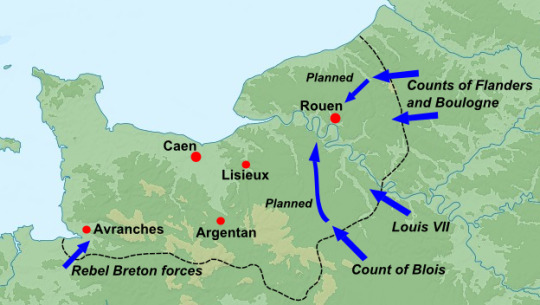
Events in Normandy, summer 1173
At the age of fifteen, Geoffrey found himself swept up in this revolt against his father, although it is doubtful that he played any significant role in the events of the time. Eventually, Geoffrey and his brothers reconciled to Henry, and a truce was reached at Gisors in 1174. Unfortunately, this uneasy peace within the Plantagenet royal family was not destined to last.
Duke of Brittany
In July 1181, Geoffrey became the Duke of Brittany and Earl of Richmond upon his marriage to Constance, Duchess of Brittany. It was a marriage that had been carefully orchestrated by Henry II.
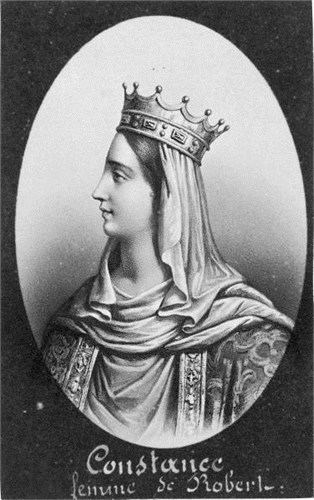
Constance, Duchess of Brittany
Years earlier, Henry had helped Conan IV, Duke of Brittany put down an uprising. Duke Conan might have assumed that Henry was helping him maintain control over the Duchy of Brittany, but Henry’s motives were much more mercenary: Henry decided that Brittany’s location on the western border of Normandy made it a desirable addition to his expansive kingdom.
After putting down the revolt in Brittany, Henry forced Conan to abdicate his title to his five year old daughter, Constance, and then he betrothed the little duchess to eight year old Geoffrey. According to Everard, Henry needed Conan’s abdication to prevent any son of the duke from inheriting the duchy in the future.
Geoffrey Plantagenet and his wife, Constance, had three children:
Eleanor, Fair Maid of Brittany, (1184–1241);
Maud/Matilda of Brittany (died in May 1189);
Arthur I, Duke of Brittany (he was born in 1187, after Geoffrey’s death, and was presumably killed in 1203 by his uncle, John I of England).
Another Revolt
By 1182, Plantagenet family tensions were once again reaching a boiling point.
Henry the Young King grew increasingly frustrated that his coronation had brought him relatively little wealth and no real power. Meanwhile, Richard ruled Aquitaine, where disgruntled nobles were able to exploit the tensions between the three brothers. Geoffrey joined Henry the Young King and threatened Richard. King Henry was required to intervene in an attempt to cool the tempers of his fractious brood.

Revolt against Henry II
It is the resolution of this second revolt where historians get their first glimpse of Geoffrey’s nature and temperament. Henry II and his sons all met in Anjou, at Mirabel, and the three sons took oaths that they would be obedient to the rightful King of England, their father, and would not rebel again.
Soon after taking this oath, Henry the Young King contracted dysentery in June 1183 and died in the Castle of Martel, near Limoges.
Following this second revolt, we get our first glimpse into the nature and personality of Geoffrey from a chronicler of the time, Roger of Hoveden:
“But the said Geoffrey, utterly forgetful of God and of respect for his father, and unmindful of his commands, did not bring peace, but the sword, and, slighting his oath, his homage, and the fealty which he had so often sworn to his father, entered into a compact with the enemies of his father, for the purpose of harassing him, and induced a sacrilegious race, and one detested by the Church of Rome, to ravage the territories of his father.”
Geoffrey allied himself with John Lackland, his youngest brother, against Richard. Later he joined with young Philippe Augustus, the King of France, against both his father and Richard. In response, Henry II made increasingly violent assaults upon any castle or fiefdom allied with Geoffrey, and, eventually, Henry and Richard captured all the rebellious castles, some of which they razed to the ground.
According to contemporary sources, Geoffrey didn’t have Richard’s great military talent, but he was a ruthless warrior who was capable of terrifying acts of violence. He was best known for his propensity to do anything to get his way. If he needed to raise funds for his campaigns, he attacked and robbed monasteries and abbeys, and it was this lack of reverence that earned him the displeasure of the Church.
Historians about Geoffrey
Roger of Hoveden called Geoffrey ‘that son of iniquity and perdition.’ In her book “Eleanor of Aquitaine: By the Wrath of God, Queen of England,” Alison Weir writes:
“Geoffrey’s life would be that of an ambitious and opportunistic robber baron. Ruthless in warfare, he plundered at will, not hesitating to sack abbeys and shrines. He had few scruples, and confronted his critics with devious and shameless excuses.”

Geoffrey with his mother, Eleanor, in the movie “Lion in the Winter”
In his biography of Henry II of England, Richard Barber says:
“Geoffrey, though skilled in military affairs, eloquent and astute, never won men’s hearts or admiration as his elder brothers had done; he took after his Angevin grandfather, in whose dry and ambitious nature these three qualities predominated.”
Geoffrey Plantagenet was a good friend of Philippe Augustus, the son of King Louis VII of France. He spent time at the French court in Paris, and Philippe even made him his seneschal (a royal steward overseeing the entire country), much to the displeasure of the English monarch. Philippe and Geoffrey acted in alliance against Henry II in the revolt of 1183-1184. Some evidence supports the claim that the two men were planning another rebellion against Henry II in the summer of 1186, but Geoffrey’s sudden death precluded them from launching it.
Having conspired sometimes with and sometimes against his elder brothers and his father, Geoffrey Plantagenet, Duke of Brittany, acquired a reputation for treachery and perdition.
A Cambro-Norman archdeacon of Brecon and historian, Gerald of Wales was a royal clerk to the king and two archbishops. He often traveled and wrote detailed chronicles. He wrote the following of Geoffrey, Duke of Brittany:
“He has more aloes than honey in him; his tongue is smoother than oil; his sweet and persuasive eloquence has enabled him to dissolve the firmest alliances and by his powers of language able to corrupt two kingdoms; of tireless endeavour, a hypocrite in everything, a deceiver and a dissembler.”
Death in Paris
At the time of his death, Geoffrey Plantagenet was at the French court. There are two alternative accounts of his death. The most popular version is that the Duke of Brittany was trampled to death in a jousting tournament. According to Roger of Hoveden, Philip was so grief-stricken and devastated that he attempted jumping into the coffin – this is likely an exaggeration, although other chronicles also give some details of Philip’s hysterical grief.
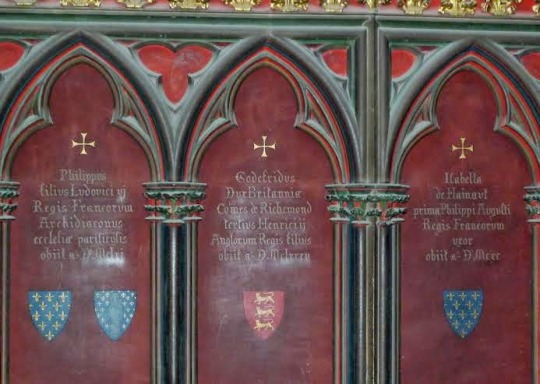
Geoffrey’s tombstone
According to the chronicle of the French Royal clerk Rigord, Geoffrey died of sudden acute chest pain in his chest, which was said to be his punishment for plotting against his father and for his lack of respect to the Lord. In this chronicle, it is said that Geoffrey was struck by that illness immediately after boasting to Philippe of his intention to lay Normandy to waste. It is typical of this time period for chroniclers to invent a manner of death that provides a sense of justice for the sins of the person who has died. Most historians doubt the veracity of this account of Geoffrey’s death.
Likewise, some historians think that the story of Geoffrey’s death in a tournament was invented by Philip in order to keep Henry II from learning about a new plot against him.
However, it is known that Geoffrey Plantagenet enjoyed tournaments and did participate in them.
Because he drew his last breath in France, Geoffrey’s body was not taken to England for burial. He was put to eternal rest in the choir of Notre Dame de Paris Cathedral, but his tombstone was destroyed in the 18th century, before the French revolution.
All images are in the public domain.
Text © 2017 Olivia Longueville and J.C. Plummer
19 notes
·
View notes
Text
Some More Werdales And Wardales
The earliest recorded is….
John de Werdale 1273-1312 murdered on Holy island by order of the bishop at the time
Before that date there are various options one being that John was a younger son by the 2nd wife of Robert de Neville who took the name Werdale when he became a forester of Weardale.
Holy Island is of course Lindisfarne but I’ve no idea who the bishop was.

(Michael Wardle does have a family history site which may go back to William de Wardley 1165-? but the list he sent me only goes back to 1273.)
William de Wardale was around from 1296-1364. He had a son John….
Name
John Werdale
Birth
1375
Brancepeth, Durham, England
Residence
acquired lands in 1401 and at Brancepeth later, Darlington, Houghton Le Spring, Durham, England
1401
Military Service
under Sir Ralph Babthorpe, comptroller of the King's household
Oct 24 1415
Agincourt, Meurthe-et-Moselle, Lorraine, France
Employer
Squire to Ralph Neville 1st Earl of Westmoorland, at Brancepeth
Before 1416
Employer
Squire to Sir John Neville eldest son of the Earl of Westmoorland
1417
Caen, Calvados, Basse-Normandie, France
Death
killed c. 1430 in France
John had a son called Robert 1404-1477
Robert Werdale
Name
Robert Werdale
Birth
1404
Brancepeth, Durham, England
Birth
Before 1430
Employer
1464 Auditor of the Neville estates
Employer
1462-1463 J.P. to the Palatinate
Employer
1435-1476 Clerk of Works to Bishop Robert Neville 1437-1457 Auditor of Durham Chancery Rolls 1439-1464 Commissary to gold Halmote Courts and Courts Baron in the Palatinate 1457-1466 King's Justice
Employer
1459 Sub-seneschal of Durham to John Neville, Lord Montagu/
1459
Death
Circa 1477
A Palatinate was part of a county which had something similar to home rule.
Christopher Wardale 1435-1500 was a lawyer/clerk employed by Durham Priory.and his son William 1463-1515 was a merchant. His son was also called William 1495-1565 and married Cecily Wardale. He acquired the property of Elvet Hill, Durham in 1527.
His son was another Christopher 1527-1611 who married Jane Wardell in 1549.
0 notes
Photo
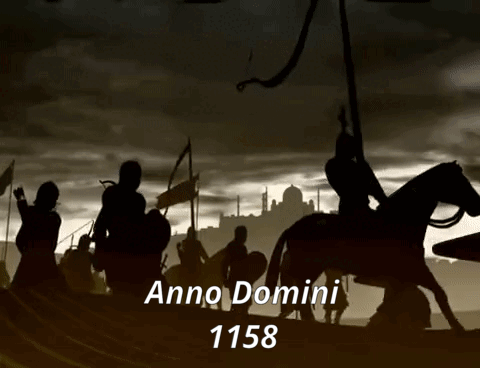




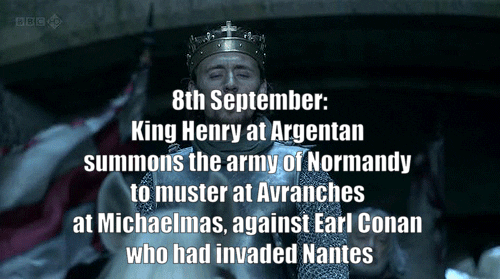
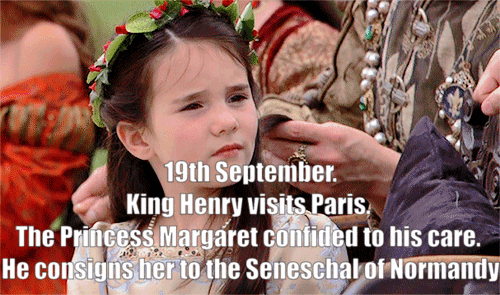
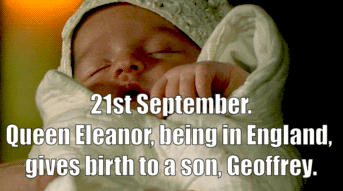

Selected events of Henry II’s reign.
<<A.D. 1158>>
Jan: The King at Carlisle, grants the honour of knighthood to William Earl Warren, but refuses it to Malcolm, King of Scots.[...] The King fortifies the Castle of Were, i.e., Wark in Wark, or Werk. Northumberland.
A Charter, dated at Nottingham, and addressed to Nottingham. Robert, Bishop of Lincoln; whereby the King certifies that he has restored Ricardo de Haia Constabularlam suam de Lincolscira et custodiani castelli mei de Lincoln* et terram qua fiiit joatris ejus. Witnesses, Thorms the Chancellor; Reginald, Earl of Cornwall; William, the King's brother; Richard de Humez, Constable; Robert de Novo-burgo ; R. de Sancto Remigio. A Charter, dated at Nottingham in favour of Furness Abbey, attested by Earl Reginald (of Cornwall) ; Robert, Earl of Leicester; Warin fitz Gerold, Chamberlain ; and Manasser Biset, Dapifer.
Feb-March: During these two months the King probably visited Oxfordshire, Hampshire, and Wiltshire. The Charters which we may refer to this period, are:
One, dated at Woodstock, whereby the King gives "to William Malduit, son of William Malduit, my Chamberlain, the Barcny which was his father's on the day that he became the King's man at Wudestoc, to wit, Hameslape and Maneton, which I gave to his father at Nottingham."
Witnesses, Robert, Bishop of Lincoln; Thomas the Chancellor; Richard de Haia; Robert de Montfort ; William de St. John ; William de Caisneto ; Hugh de Piris; William de Lanval ; and William de Watevill. [...]
April: [...] from Worcester, it is probable that the King passed to Tewkesbury. A Writ, there dated, and attested by Tewkesbury. Gregory (perhaps a clerk of the King), admonishes the tenants of the Abbey of Malmesbury that they perform due services to the Abbey.
This year is distinguished as one in which the King is said to have made a summer progress. [...] there is some probability that between April and August of this year, the King visited London. — A Charter, dated at Westminster, is in favour of Bermondsey Priory, and is attested by Theobald, Archbishop of Canterbury ; Thomas the Chancellor; and Manasser Biset, Dapifer.
July 27: Geoffrey, the King’s brother, died at Nantes.
August. Just before his transfretation to Normandy, was engaged in hostilities with Rese, Prince of S. Wales, from whom he (South Wales.) received hostages.
The year 1158 must be assigned to this fact (if such it was), not the year 1157, as the Welsh Chronicle has it. In the same month of August the King crossed the Portsmouth or sea to Normandy. He probably embarked from Portsmouth or Southampton, leaving the Queen at Winchester.
King Henry holds a conference with Louis VII. on the inter Gisors and River Epte. They agree on a marriage between Prince Henry of England and the Princess Margaret of France.
September:
8th. King Henry at Argentan summons the army of Normandy to muster at Avranches at Michaelmas, against Earl Conan who had invaded Nantes.
19th. King Henry visits Paris. The Princess Margaret confided to his care. He consigns her to Robert de Newburg (then Seneschal of Normandy). The King is said to have been now at Mantes.
21st. Queen Eleanor, being in England, gives birth to a son, Geoffrey.
29th. King Henry at Avranches. Earl Conan appears before him, and surrenders Nantes. Henry makes Conan a Duke. The Chancellor (Becket) and Henry de Pomerai appear in the above year, acting exceptionally and in three counties, as judicial functionaries. There was no regular Iter in the English provinces.
October:
9th. Oct. 9. The King goes to Nantes, in Bretagne. He is armed with additional powers against the disaffected Bretons in virtue of his office as Seneschal of France.The King besieges and takes Thouars (Castrum Toarcii). The King goes to Le Mans/ and there meets Louis of France.
November:
23rd: The King accompanies Louis VII visiting the Norman Abbey of St. Michael in periculo maris (Mont St. Michael). Both Kings adjourn to Avranches.K. Henry is next found at Baieux with Louis. Then at Caen. Then at Rouen, still entertaining Louis. Another authority seems to trace a nearly contemporary progress of the King through Normandy as bringing him successively to Pacey. And to Evreux. And to Neufbourg. And to Bee.
29th. The Queen is now at Salisbury. Richard de Luci is acting as a Justiciar in England. We have a precept of "Alianore, Queen of England, Duchess of Aquitaine and Normandy, and Countess of Anjou" in behalf of Matilda, Countess (dowager) of Chester. It is dated at Salisbury, and attested by Joceline de Bailol. Also we have a Certificate whereby " A.,Queen of England, etc.," confirms a quit-claim given in her presence by Robert Flambard to Warner de Lusoriis. Witnesses, Gosceline, Bp of Sarum; Earl Reginald
Sources: “Court, Household and Itinerary of K. Henry II”.
Fancast: Tom Hiddleston as King Henry II of England; Sam Claffin as Earl Conan; David Oakes as Geoffrey of Anjou; Daniel Gillies as Reese, Prince of South Wales. (Gifs are not mine to claim ownership. They are only used here to illustrate the characters and events of history.)
#Henry II of England#Henry II#King Henry II of England#King Henry II#Henry Fitzempress#Henry Curtmantle#House of Anjou#Angevins#Angevin Empire#Angevin Emperor#House of Plantagenet#Plantagenet#Plantagenets#Plantagenet Dynasty#Tom Hiddleston#David Oakes#Sam Claffin#Plantagenet edit#Eleanor of Aquitaine#Geoffrey Plantagenet#Geoffrey of Brittanny#Matilda of Normandy#Matilda of England
18 notes
·
View notes
Text
from 'RittenhouseTL' for all things Timeless https://ift.tt/2IMGCGB via Istudy world
the alchemical wedding: chapter seven

Summary: Discovery of Witches AU. When Dr. Lucy Preston, historian and reluctant witch, stumbles on an enchanted alchemical manuscript, Ashmole 782, in Oxford University’s Bodleian Library, she crosses paths with the mysterious vampire Garcia Flynn. They must work together to discover its secrets, their conflicted family legacies, and the shadowy enemies who want to claim it. As they do, they are increasingly and unwillingly drawn to each other, but that may be the most dangerous and forbidden magic of all. Rating: M Status: WIP Previous: Friggin’ Twilight
Chapter Seven: Sept-Tours
The next several hours are a blur. At least the fact of having come directly from Woodstock means that they still have Lucy’s things and don’t need to make a very risky trip back to her flat, and Flynn really wants to get out of here. He keeps looking over his shoulder, staring evilly after presumably innocent passersby, and it is not long later when he has bundled the still-shocked Lucy into the car and they are driving back up the A44 anyway, in the direction of Oxford Airport. Jiya has come with them so she can take the car home, but she keeps throwing dark looks at Flynn from the passenger seat. Finally, as they’re about to turn into the airfield, she mutters, “Do you really think this is a good idea? Taking her to Sept-Tours? Grand-mère is not going to like this.”
“It’ll be fine.” Flynn is, of course, well aware of his mother’s feelings on witches, some of which he was just explaining to Lucy the other night. “She knows what I’ve been trying to do with Ashmole 782, and she doesn’t even have to see Lucy if she doesn’t want to.”
“You’re still asking her to welcome a witch wanted by the entire creature world and hunted by the Congregation into her house,” Jiya says, low-voiced. “With no warning at all. Dad, just – call Cecilia ahead of time or something, okay? Please.”
Flynn utters an impatient noise in his throat, even as he knows this suggestion is made with preventive intent. Cecilia is, apart from Houdini, the de Clermont family’s other long-term servant. She’s from eleventh-century Normandy and still mostly only speaks Old French, pretending not to understand when anyone addresses her in “that slang,” but she has lived as Sept-Tours’ chatelaine, seneschal, and general manager of the estate for centuries, and is, if nothing else, used to interceding with Maria de Clermont on behalf of her idiot sons. Cecilia is formidable and sharp-tongued (she used to be an abbess at Holy-Trinity in Caen, and Flynn can imagine her absolutely terrifying the novices), but she is fond of the boys, and will probably at least prepare the way. So much as it can be prepared at all.
“I’ll call her once we’re en route,” Flynn says at last. “See if she can have a car waiting at Poitiers. But still – ”
“Just don’t walk up the drive with Lucy for the first time and spring it on Grand-mère like that, all right? Are you sure you couldn’t do this in Woodstock?”
“Yes.” Flynn accelerates through the automatic barrier and looks around for the car park. “It’s too close to Oxford, all the hornets’ nests have been kicked, and all my archived work is at Sept-Tours. Besides, it’s the one place the Congregation or anyone else absolutely won’t dare to go. I can’t get this finished if I’m keeping one eye on Lucy the whole time.”
“She just conjured witch-wind, from what you said,” Jiya counters. “Are you sure she really needs your help?”
Flynn has the distinct feeling that this is offered as a condemnation of his help, rather than high praise of Lucy’s novice abilities or any suggestion that she should actually be left on her own, and settles for an affronted harrumph. They turn into an empty bay, he parks, takes out the keys, and tosses them to Jiya. She is wearing the expression that means she suspects her advice has gone in one ear and directly out the other, and slides over into the driver’s seat. “At least text me when you get there and nobody’s dead, all right?”
Flynn agrees, opens the back door, and shows Lucy out, as she grabs her bag and gives him a worried look that might suggest she did in fact overhear all that. “Is everything going to be all right with this? I mean, I’m a witch, and you said your mother hated witches.”
[read the rest on AO3]
0 notes